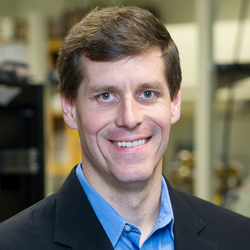Improving the Tiniest Elements of Quantum Communication
Researchers develop method to better control how single-photon emitters produce light
The goal of quantum communication is to send information quickly and securely through encrypted channels. Improving that process is not an easy task and requires delicate work to control how light is released by single-photon emitters.

These emitters can be hosted in two-dimensional (2D) materials, and a team led by Northwestern Engineering’s Mark Hersam found that changing how the surface of these materials is chemically treated can influence the purity of the light that is emitted. This is an important step because it gives researchers more control over how the single-photon emitters produce light, potentially allowing scientists to create better technology for sending information securely through quantum communication.
“We anticipate that this work will advance the development of more efficient quantum communication protocols and quantum computing devices in addition to impacting the broader fields of nanophotonics and 2D materials research,” Hersam said.
Hersam and his counterparts presented their work in the paper “Chemomechanical Modification of Quantum Emission in Monolayer WSe2,” published April 17 in the journal Nature Communications. Hersam is Walter P. Murphy Professor of Materials Science and Engineering at the McCormick School of Engineering and director of the Materials Research Science and Engineering Center (MRSEC).
We anticipate that this work will advance the development of more efficient quantum communication protocols and quantum computing devices in addition to impacting the broader fields of nanophotonics and 2D materials research.
Mark HersamWalter P. Murphy Professor of Materials Science and Engineering
Single-photon emitters, which create exactly one quantum energy packet of light at a time, are produced in 2D semiconductors such as monolayer tungsten diselenide by mechanically straining the material. Current methods, however, result in irregular mechanical strains and cause the single-photon emission spectrum to become complicated and irreproducible, limiting quantum communication applications.
Hersam and his colleagues came up with a novel “chemomechanical” method to improve the single-photon purity of quantum emitters by combining localized mechanical strain with chemical surface functionalization.
“By revealing conditions under which chemical functionalization can tune single-photon emission, this work significantly broadens the parameter space for controlling quantum emission in 2D materials,” first author Iqbal Utama said. “Our work demonstrates how chemical surface modification can tune the optical properties of 2D materials, thus providing additional opportunities for tailored nanophotonics.”

This research could set the stage for practical applications in industries such as banking and defense, where the secure transmission of confidential information is crucial.
“We are now investigating different chemistries and functionalization schemes to further improve the single-photon emission properties from additional 2D materials,” Hersam said. “Given the large number of permutations between different chemistries and 2D materials, we anticipate a flood of additional work in this field.”
This highly collaborative work involved multiple Northwestern faculty members including Tobin J. Marks, Emily Weiss, George Schatz, and Nathaniel Stern, in addition to researchers from Argonne National Laboratory and Japan’s National Institute for Materials Science. The research for this paper was primarily supported by the Center for Molecular Quantum Transduction, funded by the US Department of Energy. The work was also performed in part at the Northwestern University MRSEC.